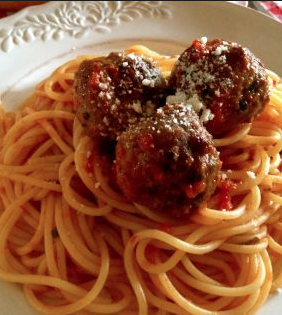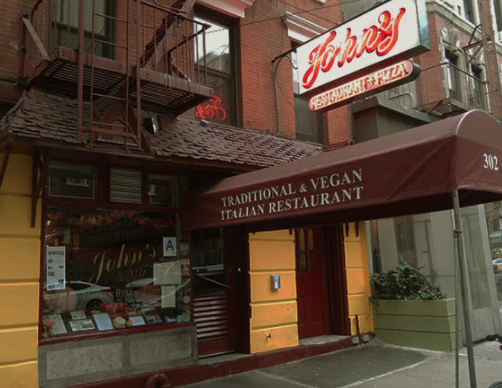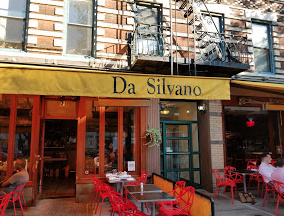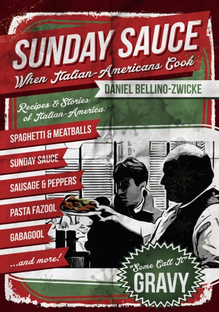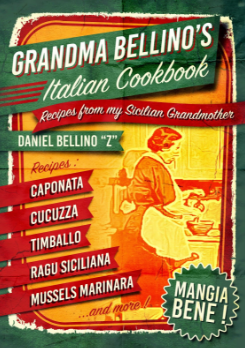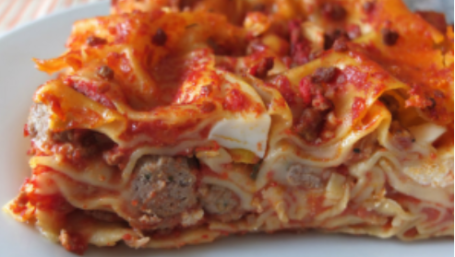.
.
In the home of my family in the Lodi, New Jersey there was a constant array of Italian favorites on the table. There was always fresh Mozzarella, Italian Bread, and Salami and dishes like; Ravioli, Lasagna Aunt Fran’s Eggplant, Chicken Cacciatore, Beef Braciola, Aunt Helen;s Sunday Sauce Gravy with Sausage, Meatballs, and Braciole. My uncles drank Carlo Rossi “Paisano Wine” or Gallo Hearty Burgundy, both wines from Italian American immigrant families. After dinner my aunts and uncles drank Espresso that Aunt Fran or Helen brewed in the old Napoletana Espresso Pot. It was during the 1960s and 70s and my Mother, my aunts, and Uncle Tony were all great cooks. Yes on Sundays, we often ate that famed Italian dish that some call Gravy, while others call it Sauce, Sunday Sauce, or Sunday Gravy. We had Sunday Sauce, or if not that, it could be Chicken Cacciatore, Ravioli, Spaghetti & Meatballs, Uncle Tony’s famous Veal Marsala or some sort of Roast Beef or Pork. The dinner usually started with a Mixed Antipasto of Salami, Roast Peppers, Olives, Celery, Mozzarella, and Provolone Cheese. Then we’d have our main course, and followed my Espresso or American Coffee and a Hug Assortment of Italian Cookies, Cake, and Pastries, and a whole lot of Chit Chat.
The Italian American Kitchen was a mixture of hearty dishes from immigrants of Sicily, Napoli and Campania, Abruzzo, Calabria and all of Southern Italy.
The history of the rise and fall and rise of Italian cuisine is fascinating; It is an American story, the plot is intertwined with entrepreneurial spirit, the embrace of pop culture, the spread of convenience products and creativity from home cooks who reported the culinary spirit of our country. This began in an authentic way with Italian immigrants, who could at least do their best. The Abbondanza known from Italian-American cuisine is due to the fact that these immigrant cooks, most of whom came from extreme poverty, are proud of the opportunity to feed wasteful family and friends with the types of food they bring could not pay at home. Ingredients such as mozzarella and ricotta are no longer used as accents, not as food itself: they are prepared with waste. Lobster father fra Diavolo the seafood tomato dishes is probably inspired by prickly sprouts or cheap lobster in Italy is another example, if it became popular in the 50s in the Italian-American restaurants, became a court fancy, much bigger and taste than its predecessors , Lobster New England baked in a fiery tomato sauce. An additional component of the cuisine of southern Italy, calf, is the first Italian-American menu in countless ways: Veal Parmigiana (breaded and topped with sauce and cheese), Veal Marsala (enriched with wine) and often filled with mozzarella and raw ham, then garnished with tomato sauce.
The country’s food has become a jumping-board for the invention in the United States. Take a pizza that evolved from the simple roots of the different styles to those in Italy (see how you slice it), more cheese, sauce and ingredients. Or, ketchup, by the way: When my wife and I first went to Italy in 1977 for the first time on a honeymoon, we saw marinara (this tomato sauce, garlic and oil cooked fast) Sundays “salsa” filled with all sorts of meat that most Families I have known will grow up on Sunday. The tomato sauce is, of course, in Italy, the irony is that the tomatoes were brought to America in the 16th century and were regarded as poisonous by all, with the exception of those in the South who discovered them as an enchanting addition to their lean diet, that they thrive in their sunny climate. South, emigrated to America between 1890 and 1910, brought tomatoes and tomato sauce. All cooks had a version and became the food in which immigrant women vied their neighborhood in their neighborhood. When we grow up, we would not offend any more from a friend than from his mother or grandmother. The sauce was sacred.
JOHN’S of 12th STREET is one of America’s most Classic Italian Red Sauce Joints
Opened in 1908, John’s is till open with all its Original 1908 decor.
Soon, the red sauce became the emblem of Italian cuisine in the United States, which was taken over by Americans of all experts by ethnic restaurateurs and marketed as part of the abundance of cooking groups. My family ate at least once a week, mostly in a place called Amerigo in the Bronx, which began in the 1930s as a pizzeria and became a restaurant of exceptional width with a menu that ranged from Antipasti to Zabaglione, and dining room decorated with a lighted cascade and a mural by the neighboring bridge Throgs Neck. He was in restaurants like Amerigo, which we had enjoyed with the kind of elegant dishes that Mom had made during the week: I always had the gnocchi in tomato sauce and my brother manicotti. My father ordered a huge New York steak which was given to Italian butcher by Italian butcher. My mother had a filet of the only “Livornese”, a mussel dish and mussels, white wine and a moderate amount of garlic. The portions were huge, including the cheesecake and cannoli for dessert. A waiter came to the table to beat Zabaglione in a large pot of copper.
The ultimate in this dining style was Mamma Leone at 48th Street in Manhattan. This multi-storey show kitchen was opened in 1906 with nude statues and blocks of mozzarella and provolone on each table and operated by the same family until it was sold to a group of restaurants in 1959. closed in 1994. If Verdi had eaten there, I would have written an opera about it, and Enrico Caruso and Luisa Tetrazzini, both immortalized in the pasta dishes that bore their names, would have sung the tracks.
As much as Americans like places like Mamma Leone, Italo-American food, which is often called “headless” with “Greasers” and “garlic eaters”. “It was only in the 1970s and 1980s that high – quality quality ingredients were introduced in Italy, many of which were forbidden by the commercial laws in the 1970s and 1980s United States such as Parma ham, extra virgin olive oil from different places, Parmesan cheese- Reggiano, arborio rice, Funghi mushrooms, balsamic vinegar and good Italian wines from producers Angelo Gaja and Giovanni di Piero Antinori.
At this time, many Italian-American restaurants were tired and tired, and some restaurateurs tried to refine clichés and prices, which justified the use of Northern Italy as a source of inspiration. In New York there was Romeo Salta (inaugurated in 1953), Nanni (1968) and Il Nido (1979); in Santa Monica, Calif., Valentino’s (1972). All factors minimize the red sauce, replace buttersauce and cream and give 20 dollars a plate of risotto and especially polenta, a dish that was the basic food of the poor in Northern Italy, could afford to eat something This meal plus was considered authentic Italian region received: lasagna with meat sauce and meatballs was discarded in favor of alla Bolognese lasagna with pasta with spinach and bechamel. Italian-American cheese and cannoli were replaced by Tiramisu and Panna Cotta. Old bottles of Chianti in Fiaschibaskets of straw were abandoned in favor of Barolo, Barbaresco and “Super Tuscans”. The wall paintings on Mount Vesuvius were painted in favor of photos by Sophia Loren and Marcello Mastroianni. The red-checked tablecloths disappeared; Now the tables were decorated with Frette leaves.
The air of time would look northward for another reason: Italian fashion and design (in the northern cities like Milan and Florence) were very popular in the USA in the 1980s. UU. They proclaimed that they were trattorias or grills in the Tuscan style (even if they did not serve any Tuscan food). Among the first to promote Tuscan origin are Da Silvano, which was inaugurated in 1975, and Il Cantinori (1983). Both, still in the Greenwich Village in New York, have become editors of well-known magazines, art galleries and other members of the cultural elite. In a short time their menus were copied all over the country, and extra virgin olive oil became the new red sauce.
Da SILVANO
The New Breed Italian Restaurant that started spring-up in the early 1980s
This inspired in northern places adopted Italy, the principles of Mediterranean diet, the name of a book written in 1994 by the author of the cookbook (and rescuer contributor) Nancy Harmon Jenkins. The main argument is that what they ate real Italian, a diet rich in vegetables, seafood, grains and olive oil, was much healthier than those rich in meat, fried, drowned food laden with cheese and Italian red sauce. Quickly sauteed vegetables and farro were in; The chicken parmesan and dumplings were on the outside.
But who does not like meatballs? As influential as the Mediterranean diet, Italian cuisine, which is highly likely to be in London, Berlin, Moscow or Mumbai much closer to the old original form of the “red sauce” will be that of the regional Italian menu with white truffle Alba, Sardinian cheese or sepia Risotto Venice. Even the pioneers of modern Italian food supplies in America, while proudly serving regional specialties, always adhere to the good old Italo-Americans, even if the names change. addictive and candied dumpling flavored sugar known as the zeppole canon American Italian often appears similar to Bombolini, and what is called smooth macaroni is now divided into specific classifications or Rigatoni Rigate or Garganelli Casarecci Osteria Morini in New York City before Michael White, born in Wisconsin and trained in San Domenico, 3 Michelin stars Bologna, serves primarily Emilia-Romagna style cuisine, but also offers meatballs with tomatoes and pasta with white mushroom sauce.
The BELLINO’S
Fillipo , Lucia (My Mother), Tony, and Nonna Giuseppina
Bothers Jimmy and Frank and sister Lilly are not in this picture. Lodi, NJ 1940
RAO’S … 114th Street and Pleasant Avenue in East Harlem New York , NY
SINCE 1896 and almost “Impossible to Get a Table There” which are owned by the Rich, Famous, “Connected” and Influential … That means Rich, Movie Stars, Rock Stars, Professional Athletes and MOBSTERS !!! Basta !
Another difference is that Carbon and Torrisi, which often refer to the Asian influences of neighboring Chinatown on their menus, use only American products. Nothing was important, not ham, tomatoes, spaghetti or breadcrumbs, because what about progress? The message is clear: it must not be directly from Italy to be something special. And if it was good enough for the Italian cooks, then this is good enough for us.

GINO’S was a Favorite of Frank Sinatra, Gay Talese, and other Celebs.
Sadly GINO’S Closed in 2011
Every time I eat in a new-breed Italian-American restaurants, I never expect the food to taste like that of my dear Aunts Helen and Fran. These restaurants prove that Italian-American Cuisine is a true cuisine in its own right, as it has developed like any other great cuisine in the history of the world. Many writers and so-called food experts have often maligned Italian-American food (cuisine) over the years, “saying this isn’t Italian.” Favorite Italian-American dishes like Chicken Parm, Veal Parmigiano, and Spaghetti & Meatballs have really been beaten up by some of these food critics, saying “Italian’s never eat Spaghetti & Meatballs in Italy,” and what-not. Well I’ll tell you something. Italian do eat Pasta with Meatballs in Italy, and especially in the south in Campania, Puglia, and Sicily. Maybe not Spaghetti and Meatballs, but usually short baked Maccheroni like Ziti al Forno which is Ziti baked with Tomato Sauce, little Meatballs and Pecorino and or Caciocavallo Cheese. This is a traditional dish served at Sicilian Weddings as Pasta Seduta in Puglia.
Frank Sinatra with Ava Gardner at PATSY’S ITALIAN RESTAURANT
West 56th Street , New York , NY
